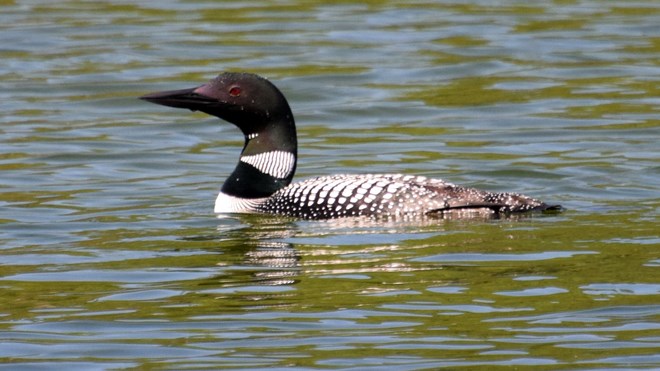A dark shadow floats on the water, low silhouette, bobbing with the small waves gently undulating in the cool December breeze. It is not seasonably cold yet so the ice is only located in the stagnant bays and corners of the shore line.
She is a hanger-on at Ramsey Lake. Perhaps humans aren’t the only lifeform prone to putting things off. The migration, I mean. She will swim along the shore and work her way out into the deeper water as the urge arises. Submerging, you will have to wait and look further than from where she disappeared. She can swim underwater, sometimes great distances. For a photographer, second-guessing may be the order of the day. Now where did she go?
The earliest date of the spring arrivals is second week in April, the spring migration. In fall, they leave for the most part by September, but there are always some hangers-on. There is no alternative when the lake freezes over, and occasionally there is a story of a bird caught in a small ice-free puddle in the middle of a lake that needs rescue. Usually these birds carry a shot gun pellet or two in their wing or bodies that prevented them from escaping the cold. A misidentified “duck.”
Common loons are symbols of the north. Many a cottager reflects on their wilderness experiences with the plaintive call of the loon as backdrop to their fishing experiences. Loons have sexual dimorphism, which is a fancy expression for male and female body-size differences. It is why I used the word “she” in the beginning.
The female is the bigger bird of the pair because she is the egg producer and layer. Loons are long-lived birds, if the environment they live in stays healthy. They are also slow to make a come-back if something happens because only two eggs are laid a year and usually only one offspring will reach the immature stage.
There are stories of people reporting loons on their lakes for years and suddenly none return.
There needs to be new birds, new discovery and new establishments once the lake has lost its traditional population. They nest close to water as their legs are far back on the body, and water is their protection. Evolution has created an impressive diving, swimming “machine” at the cost of being a poor walker. The nesting site can be a floating mat of vegetation or a mound close to some shrubs and trees on a small island.
The stability of the water table is crucial during the incubation stage. In an aquatic system where there are dams that change water levels during the breeding season, the nest can get flooded or left high and dry, which would result in nest failure. Unlike many other birds, loons will seldom re-nest after nest failure in a given year, another reason for slow recruitment. This year Ramsey Lake had several young on the lake.
She pops out of the water again and elects to stay on the surface. The camera auto focuses and an image is captured. The day is gloomy and grey and the lighting poor, but there is enough to tell that it is a common loon in mid- December.
She has been here for a few days so fishing must be good! Let us hope she leaves before the ice becomes permanent.
Chris Blomme is an executive member of the Sudbury Ornithological Society and works with animals at Laurentian University. Have a question for Chris? Send it to [email protected].
